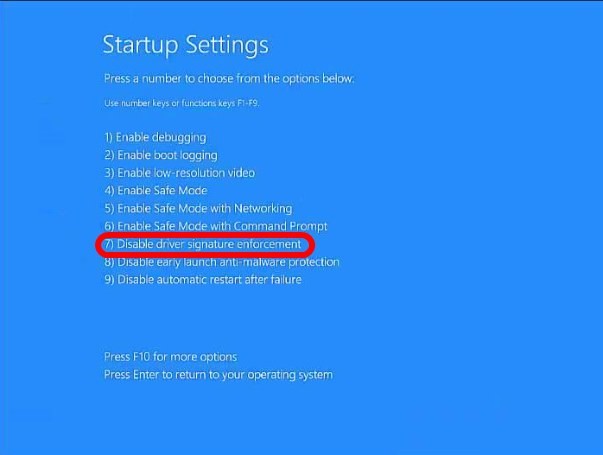Enable Driver Enforcement Windows 10
This post will show you how to disable Driver Signature enforcement in Windows 10/8/7 permanently. Driver Signing is the process of associating a digital signature with a driver package. Windows device installations use digital signatures to verify the integrity of the driver packages and to verify the identity of the vendor who provides the driver packages.
- Enable Driver Signature Enforcement Windows 10
- Enable Driver Signature Enforcement Windows 10 Permanently
- Enable Driver Signature Enforcement Win 10
- Re Enable Driver Signature Enforcement Windows 10
- Windows 10 Enable Signed Driver Enforcement
- How To Enable Driver Enforcement Windows 10
Disable / Enable Driver Signature enforcement on Windows 10 1 Use Advanced Boot Menu. Hold down the Shift key while choosing the 'Restart' option in Windows. 2 Disable Device Driver Signing. This will automatically disable driver signature enforcement on. 3 Enable Test Signing Mode. A menu will appear where you can press “7” on your keyboard to choose “Disable driver signing enforcement“. Now Device Driver Signing should be disabled, allowing you to install any driver you like in Windows 10 until you reboot.
The drivers you normally install on your computer from Windows Update, Original Equipment Manufacturers or some 3th-party driver download software, etc. must be digitally verified by Microsoft via a digital signature. It is an electronic security mark that certifies the publisher for the driver, as well as all the relevant information related to it. If a driver isn’t certified by Microsoft, Window won’t run them on either 32-bit or 64-bit system. This is referred to as “driver signature enforcement”.
Windows 10 will load only Kernel mode drivers signed digitally by the Dev Portal. However, the changes will affect only the new installations of the operating system with Secure Boot on. The non-upgraded fresh installations would require drivers signed by Microsoft.
At times you may receove a message – Windows requires a Digitally Signed Driver. If you wish you can disable Driver Signature enforcement. Let us see how to do it.
Disable Driver Signature enforcement on Windows 10
There are three options available to you,
- Use Advanced Boot Menu
- Enable Test Signing Mode
- Disable Device Driver Signing.
1] Use Advanced Boot Menu
Hold down the Shift key while choosing the “Restart” option in Windows. Your computer will restart with Advanced Options. From the list of options displayed, select the “Troubleshoot” tile.
Next, select “Advanced options” and hit the “Startup Settings” tile.
Next, select the “Restart” button to restart your PC on the Startup Settings screen.
You will see the following screen on restart. Press the 7 keyboard key to activate the “Disable driver signature enforcement” option.
Once done, your PC will reboot with driver signature enforcement disabled, and you’ll be able to install unsigned drivers.
Having said that, the next time you restart your computer, driver signature enforcement will be disabled.
2] Disable Device Driver Signing
Enable Driver Signature Enforcement Windows 10
Run Command Prompt as Administrator and execute the following command:
This will automatically disable driver signature enforcement on your device.
Swar plugin download for windows 10. If you wish to enable this feature back again, you need to execute the following command in an elevated cmd window:

To be able to do this, Secure Boot Policy will have to be disabled. Ces edupack 2018 download.
If you decide to exit this mode, run the following command:
Hope this works for you.
3] Enable Test Signing Mode
Enabling the first option will disable the driver signature enforcement feature successfully until you choose to leave the Test Mode. To enable this option, you will have to open Command Prompt with administrative privileges. For this, type CMD in search box, right-click ‘Command Prompt’ and select ‘Run as administrator’ option.
Next, paste the following command into the Command Prompt window and press Enter:
Enable Driver Signature Enforcement Windows 10 Permanently
If a message is displayed on the screen reading “The value is protected by Secure Boot policy”, it means Secure Boot is enabled for your computer’s UEFI firmware. Disable it in your computer’s UEFI Firmware Settings to enable test signing mode via Advanced Startup Options.
Enable Driver Signature Enforcement Win 10
Restart your computer to enter test mode. A “Test Mode” watermark should be visible in the bottom right corner of your computer screen. When you see this, it indicates no restriction for installing unsigned or not verified drivers.
That’s it!
You need to know that Driver Signing is a security feature that protects your system and you should consider re-enabling it as soon as it is possible.
Related Posts:
Yesterday, I wrote a tutorial how to disable driver signature requirement in Windows 10. The mentioned solution is not permanent as the driver signature enforcement will be restored after reboot. In this article, we will see how to disable the driver signature enforcement permanently in Windows 10.
RECOMMENDED: Click here to fix Windows errors and optimize system performance
To disable driver signature enforcement permanently in Windows 10, you need to do the following:
- Open an elevated command prompt instance.
- Type/paste the following text:
- Restart Windows 10.
Re Enable Driver Signature Enforcement Windows 10
This will disable the driver signature enforcement in Windows 10 permanently. This preference will be preserved even after the reboot. So, if you need to flash an Android phone or install some old or specific hardware drivers, you will be able to bypass the driver signature requirement.
To enable the driver signature enforcement back in Windows 10, type the following command in the elevated command prompt:
Windows 10 Enable Signed Driver Enforcement
That's it.
How To Enable Driver Enforcement Windows 10
RECOMMENDED: Click here to fix Windows errors and optimize system performance